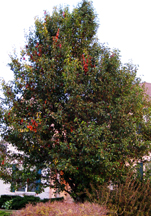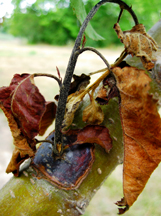Purdue expert: Trees can get 'burned' again by fire blight
May 9, 2013
 |
|
Fire blight infects ornamental fruit trees such as
this callery pear, a popular landscape tree. Symptoms include wilted shoots,
cankers on branches and blacked leaves, which give trees a "scorched"
appearance. (Purdue Agricultural Communication photo/Janna Beckerman)
|
WEST LAFAYETTE, Ind. - Homeowners who have flowering pear trees should check for signs of fire blight even if they pruned infected trees last year, says a Purdue Extension specialist in ornamental and fruit diseases.
The warm, moist temperatures last spring were ideal conditions for fire blight to thrive. Trees are most susceptible to the potentially devastating disease if a freeze occurs after blooming, as happened last year. Jana Beckerman said hundreds of cases of fire blight were reported in 2012; some neighborhoods had more than 100 infected trees.
While this spring is much cooler than last year's, Beckerman said pears and other ornamental fruit trees are not out of danger.
"If the disease carried over from last year, trees will only get worse," she said. "When trees started blooming, hundreds of different insects visited them and then spread the disease to other trees."
Beckerman said afflicted trees might not have been properly pruned last year. Trees need to be pruned 12-18 inches out from the infected area.
"The disease spreads inside the tree beyond where it is visible," she said. "If it spreads to the main stem, then the tree will die quickly."
Symptoms of fire blight are wilting shoots, cankers on branches and blackened leaves, which give the disease its name - trees appear to be scorched.
Beckerman and Lindsey Purcell, Purdue Extension urban forestry specialist, warn homeowners to also be on the lookout for disreputable people who claim that they can kill the disease-causing bacterium with chemical treatments or injections.
 |
|
Fire blight infections, such as this canker on a
crabapple branch, must be pruned out for the tree to survive. Pruning should
take place 12-15 inches away from visible canker symptoms. (Purdue Agricultural
Communication photo/Janna Beckerman) |
There is no cure for fire blight; however, some trees can be successfully pruned. Severely damaged trees may have to be removed. In some cases, the disease may have spread because homeowners were taken in by the fraudulent claims for a cure.
"We want people to be aware that no cure exists, so they are not misled into an expensive treatment," Purcell said.
Homeowners can get reputable advice or service from an International Society of Arboriculture certified arborist. A directory of certified arborists is available on the Indiana Arborist Association website at ag.purdue.edu/fnr/Associations/IAA or contact the IAA office at 765-494-3625.
Before pruning a tree themselves, homeowners should review steps outlined in Fire Blight on Fruit Trees in the Home Orchard, a Purdue Extension publication authored by Beckerman. Improper pruning can further damage trees or spread the disease. The publication is available for free download from Purdue Extension's The Education Store at http://www.The-Education-Store.com
Homeowners who have questions should contact the Purdue Plant and Pest Diagnostic Laboratory at 765-494-7071 or go to www.ppdl.purdue.edu.
Writer: Olivia Maddox, 765-496-3207, maddoxol@purdue.edu
Sources: Janna Beckerman, 765-494-4628, jbeckerm@purdue.edu
Lindsey Purcell, 765-494-3625, lapurcel@purdue.edu
Ag Communications: (765) 494-2722;
Keith Robinson, robins89@purdue.edu
Agriculture News Page

